Gold prices rise on weaker dollar, Fed easing bets; holds long-term appeal
The inflation story and the employment story are about the only things rippling the still summer waters these days, it seems. The weak employment data in the most-recent report got equity investors very excited since every analyst worth his or her salt believes that lower rates are good for the companies he/she covers, but those companies will surely be able to avoid losing business in an economic slowdown. And, to be fair, because the goods and services sectors in the US (and global) economy are out-of-sync, any recession is likely to be fairly shallow (and being out-of-sync is probably why the recession has been so delayed – different sectors are having recessions at different times.
But the fly in the ointment would be if inflation heads higher, wouldn’t it?
Well, maybe not so much. In normal times, probably. But in today’s world there is a nice, built-in excuse for any inflation uptick: it’s the tariff effect! It is amazing how focused on tariffs everybody has been, when they forecast/analyze the CPI report. The core goods sector of the economy is about one-fifth of total consumption. Tariffs will (and finally are) driving this higher, but that story will eventually pass. Core goods will not be what keeps inflation high or sends it higher in 2026. But you know why everyone wants to focus on it? Because if you can blame the inflation uptick on tariffs, then you can argue that rate cuts still make sense. More on that later, but when you look at the monthly changes in real yields and inflation expectations you can see what is happening: yields are down, inflation expectations basically unchanged, over the last month. The best of all worlds!

Which brings us to today’s report. The consensus expectations were for +0.23% on headline CPI (seasonally-adjusted), +0.29% on core, pushing the y/y figures higher for both of them as we drop off soft data from last summer. The actual prints were +0.197% on headline (yay!) and +0.322% on core (boo!). That was the highest m/m core inflation figure since January, and the first time since then that core has been higher than consensus expectations. It also was the highest m/m core number, other than January’s tariff-related spike, since March 2024.
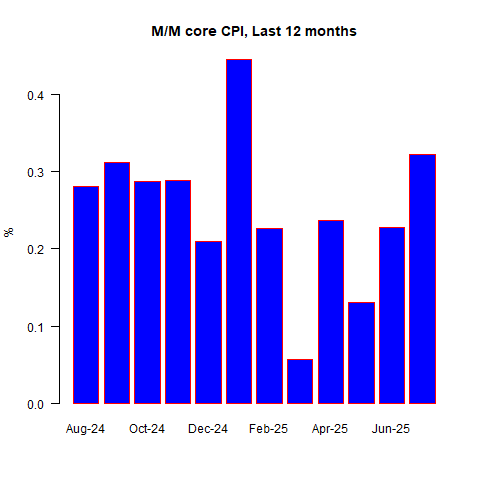
The category breakdown was interesting for a change because the top culprits were Medical (TASE:BLWV) Care, Recreation, and Other.
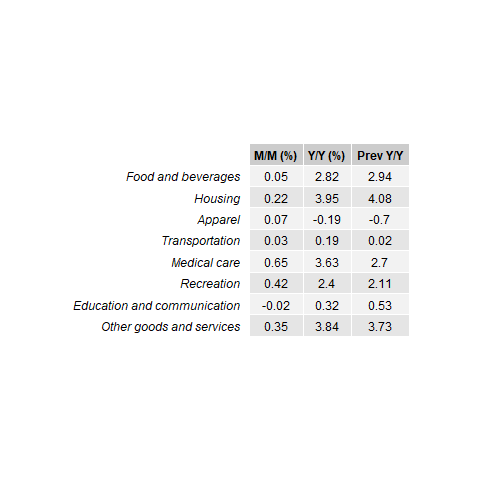
To be fair, housing would have contributed more except for another drop in Lodging Away from Home. Seasonally-adjusted prices for lodging away from home have now fallen 7.3% since January. I have been working on the assumption that this is a deportations story, or possibly a tourism story (I don’t really think ‘foreigners aren’t visiting the US because they hate Trump’ is really happening but in some quarters that’s the story they’re selling). But if you look at this chart and notice the times that hotel prices declined meaningfully, there’s an argument that it’s a recession story. Or that it could be, if it continues to slide.

Primary rents accelerated slightly m/m, +0.26% vs 0.23% last month, but Owners’ Equivalent Rent decelerated to +0.28% vs 0.30%. Both are playing to form, but it’s worth keeping an eye on Primary Rents here. Deportations as an inflation story would show up in Lodging Away from Home but it also could show up eventually in rents – but a recession wouldn’t be expected have any meaningful impact on rents. So how those two series behave might give us a clue. Or maybe not; perhaps I’m trying to read too much into this.
Core goods accelerated again. The bounce was totally expected, but now that we are over +1% (+1.17% y/y) we are clearly seeing some of the impact of tariffs. Core services is more interesting, though. Even with rents decelerating and Lodging Away from Home dropping again, Core services ticked higher.
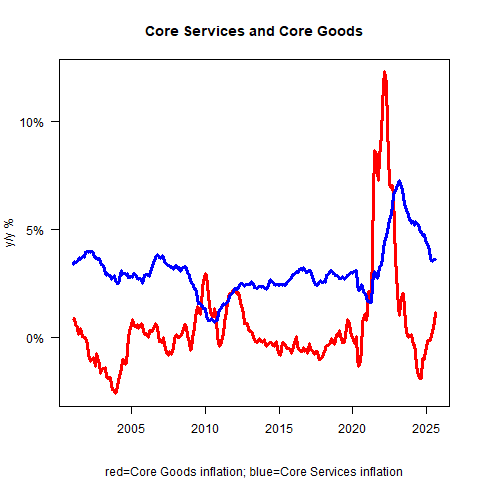
Indeed, lumping core services and core goods together, but taking out shelter, and we can see that the underlying core dynamic looks like it had been bottoming anyway and might be heading higher.
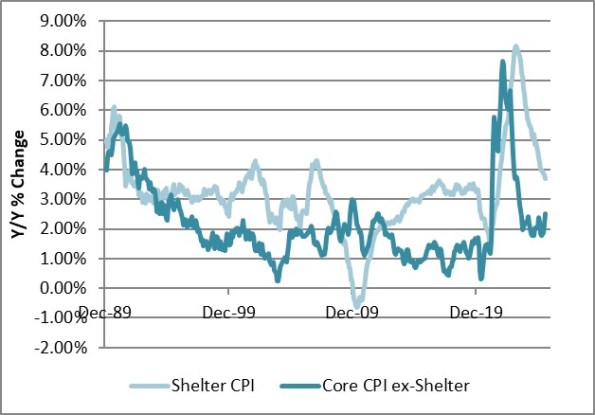
A large jump in airfares (+4.04% m/m) is partly to blame this month…but in March airfares were -5.3% m/m and the worst since 2021 while today’s number was the highest since 2022. Since COVID, airfares have just been really unstable, or the seasonals have been unstable, or both. I am not worrying too much about this jump.
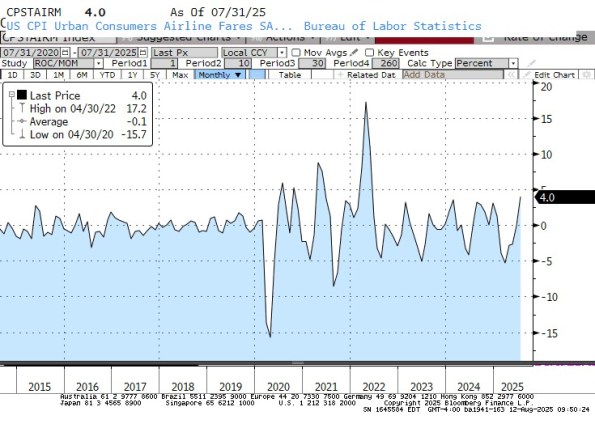
Airline fares are 0.9% of CPI, but this volatility has added to the overall volatility of the CPI. And before you say ‘this is a consequence of resource constraints at the BLS!’ you should realize that airfares are not collected by people with clipboards but by web scrapers. However this is yet another reminder that Median CPI is a better way to look the overall trend, so as not to be distracted by little categories. My early guess at Median this month is +0.276%, a bit better than last month. But there is nothing here that looks to me like a moderating trend to lower inflation.
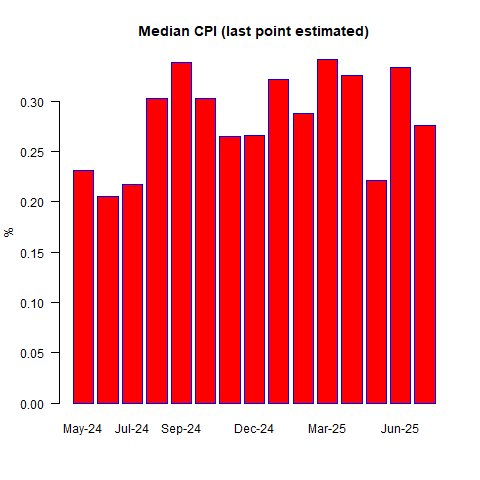
In fact, median y/y ought to tick higher again this month to about 3.65%. It is stabilizing in the high-3s. The next few monthly figures to drop off will be 0.3s, so I don’t think we will see median y/y head back to the 4% level. But having said that, there is one development that bears watching.

Core services less rent-of-shelter, aka “Supercore”, rose +0.48% m/m. If higher tariffs and deportations lead to more domestic employment and higher wages – which they should, but it isn’t yet really in the data as employment looked weak and the Wage Growth Tracker ticked down to +4.1% y/y this month – then this part is what will keep inflation uncomfortably high even if rents continue to decline (I don’t see them declining lots further than this) and goods inflation eventually declines after the tariff effect passes through. That isn’t today’s story. But it might be a 2026 story. Stay tuned.
At the tails of the distribution this month we had greater than -10% annualized monthly inflation from three non-core categories while greater than +10% from eight non-core categories – including motor vehicle parts and equipment and miscellaneous personal goods, which are tariff stories, but also tenants and household insurance, miscellaneous personal services, public transportation, and motor vehicle maintenance and repair. Those are all service stories. As is this one, although it’s also a goods story indirectly.
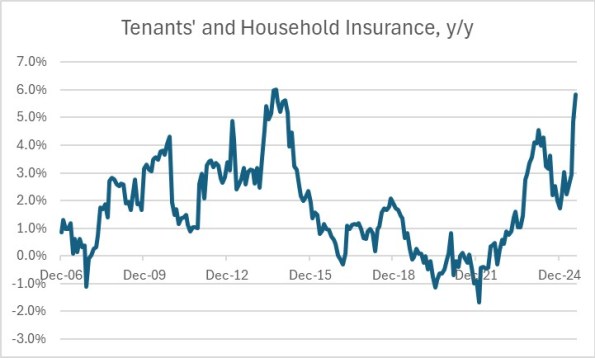
Overall, the underlying trend is the same: we’re settling in the high-3s for median inflation. Last month, I said that unless the economy starts to soften more seriously there just isn’t a good argument right now for rate cuts and the optics of rising year/year inflation would make it more challenging for the FOMC to consider an ease. That is still true. If Fed credibility matters to inflation, then inflation should start heading up because we are clearly getting more doves. If tariffs matter, inflation should be heading up because the tariffs are now showing and will be an effect for a while. If money growth matters, inflation should be heading up because M2 growth is back to +4.5% and accelerating.
But the core question is whether the Fed cares about inflation right now. Listening to their public statements, it doesn’t appear they do. One might argue that they are just supremely confident that if the Unemployment Rate heads higher, inflation will head lower so they have some room to move. To be honest, “supremely confident” and “Fed official” are not phrases that should appear in the same paragraph except sardonically. Nevertheless, the Fed is likely to ease soon, and likely multiple times before the end of the year.
And they’re worried that President Trump is going to hurt Fed credibility! That’s a little like the streetwalker who is afraid that this skirt is going to make her look cheap. Honey, that ship has sailed.
